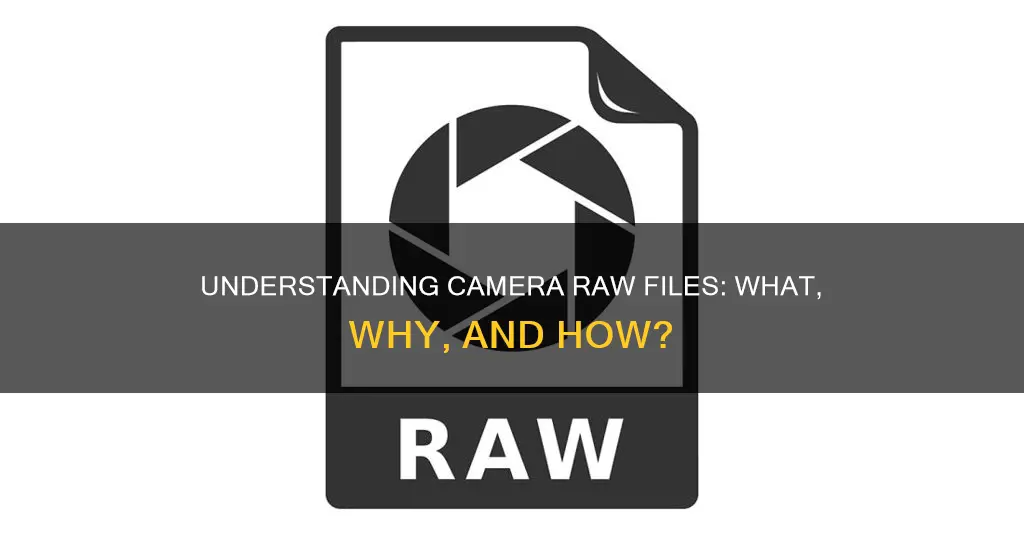
A camera raw file is a digital image file stored on your camera or smartphone's memory card. It contains unprocessed or minimally processed data from the image sensor of a digital camera, motion picture film scanner, or other image scanner. Raw files are so named because they are not yet processed and contain large amounts of potentially redundant data. They are often compared to digital negatives, although this is not strictly accurate as raw datasets are more like exposed but undeveloped film.
Raw files are usually uncompressed and contain more data than a traditional JPEG. This means that they have a wider range of possibilities inside Adobe Photoshop CC, Adobe Lightroom CC or another image editor. They are also more flexible when it comes to editing, as much of the useful image data that image editors work with is preserved.
| Characteristics | Values | |
|---|---|---|
| File type | .raw, .crw, .cr2, .cr3, .nef, .dng, .rw2, .pef, .mef, .mos, .orf, .arw, .srf, .sr2, .erf, .3fr, .dcr, .k25, .kdc, .fff, .mdc, .mrw, .r3d, .iiq, .eip, .nrw, .pnf, .rw2, .raw, .rwl, .dng, .braw, .cap, .jxs | |
| File format | Unprocessed, uncompressed grayscale picture data | |
| File size | 2-6 times larger than a JPEG file | |
| Image data | All image data is saved | |
| Image editing | More editing options available | |
| Image quality | Higher image quality | |
| Image processing | Minimally processed | |
| Image sharing | Cannot be shared without editing | |
| Image viewing | Requires specific viewing software | |
| Image printing | Requires editing before printing |
What You'll Learn
- Camera raw files contain unprocessed, uncompressed image data from a camera's sensor
- Raw files are named as such because they are unprocessed and contain large amounts of data
- Raw files are like exposed but undeveloped film, which can be converted in a non-destructive manner
- Raw files preserve the information captured at the time of exposure, including image metadata
- Raw files are intended to capture the radiometric characteristics of a scene, i.e. physical information about light intensity and colour

Camera raw files contain unprocessed, uncompressed image data from a camera's sensor
When you take a photo in JPEG format, the camera automatically processes the image, making adjustments to the white balance, contrast, colour space, and sharpening. This limits your ability to modify the image after the fact. With a RAW image, all of the data for the image is saved, so you can make all of the adjustments in post-processing.
For example, if you have a photo where the sky is too bright, or the subject too dark, with a JPEG file, it is very hard to fix this. With a RAW file, there is a massive amount of image information available, meaning you can recover skies that are too bright by reducing their brightness and increase the shadows so they are brighter.
RAW files also give you more control over the white balance of an image. White balance refers to the colour tone of an image. For example, a warm white balance will give a golden yellow tone to the image, while a cool white balance will make it appear more blue. When you shoot in JPEG, the camera has to figure out the white balance and apply it to the image. When you shoot in RAW, you can change the white balance after the fact, making it much easier to adjust the tone of the image.
Another advantage of RAW files is that they give you finer control over the sharpness and noise reduction of an image. While the camera software is generally okay at these adjustments, you get much finer control if you use a dedicated image editing tool.
Despite the advantages of RAW files, there are some reasons why you might not want to use them. RAW files are much larger than JPEG files, so they take up more space on your memory card and hard drive. They also take longer to write to the memory card, so if you are shooting in burst mode, you will be able to take more photos in JPEG format.
Additionally, RAW files are not universally recognised file types, and they vary from manufacturer to manufacturer. To view and edit RAW files, you will need specific software that supports your camera's RAW file format.
Charging Your USB Spy Camera: A Quick Guide
You may want to see also

Raw files are named as such because they are unprocessed and contain large amounts of data
A camera raw file is a digital image file stored on your camera or smartphone's memory card. It contains unprocessed or minimally processed data from the image sensor of a digital camera, motion picture film scanner, or other image scanner. Raw files are named as such because they are unprocessed and contain large amounts of data.
A raw file is like a digital negative. It is unprocessed and contains more data than a traditional JPEG. This means that a raw file has a wider range of possibilities inside Adobe Photoshop CC, Adobe Lightroom CC, or another image editor. Raw files contain more data because the camera hasn't applied any of its own adjustments to the file. This means that the image hasn't been sharpened, and if you shot in black and white mode, you still have all the colour data inside that raw shot.
A raw file is essentially the camera taking the image data from the sensor and saving it in an unedited and uncompressed format on the memory card. This takes up a lot more space on your memory card. A 20-megapixel camera will save a raw file of around 20 megabytes, whereas a JPG file of reasonable quality from the same camera will usually be around 4 megabytes.
Every camera manufacturer has its own raw file format. For example, Canon raw files are .CR2 or .CR3, while Nikon's are .NEF. When it comes to smartphones, most Android smartphones that support raw primarily shoot in DNG, a universal raw file format. Apple has a new ProRAW format.
Raw files are not yet processed and contain large amounts of potentially redundant data. They are normally processed by a raw converter in a wide-gamut internal colour space, where precise adjustments can be made before conversion to a viewable file format such as JPEG or PNG for storage, printing, or further manipulation.
Unlocking Your Camera: Powering On Without the Cover
You may want to see also

Raw files are like exposed but undeveloped film, which can be converted in a non-destructive manner
A camera raw file is a digital negative that contains unprocessed, uncompressed grayscale picture data from a digital camera's image sensor. It also includes metadata about how the image was captured. Raw files are so named because they are not yet processed and contain large amounts of data.
Raw files are like exposed but undeveloped film, which can be converted (or electronically developed) in a non-destructive manner. This means that the original camera raw data is preserved, and adjustments are stored separately as metadata. This is similar to how exposed film is a single event that physically transforms unexposed film irreversibly.
With raw files, you can make precise adjustments to the white balance, tonal range, contrast, color saturation, and sharpening. These adjustments are then stored as metadata in an accompanying sidecar file, in a database, or within the file itself (in the case of DNG format).
The ability to make adjustments without altering the original data is a significant advantage of using raw files. This non-destructive process allows for greater flexibility and experimentation without compromising the original image.
The Ultimate Guide to TAC Camera Battery Options
You may want to see also

Raw files preserve the information captured at the time of exposure, including image metadata
Raw files are named as such because they are not yet processed and contain large amounts of data from the image sensor of a digital camera. They are often likened to digital negatives, although this is not strictly accurate. Raw files are more akin to exposed but undeveloped film, which can be converted and edited multiple times without compromising the original data.
The purpose of raw image formats is to save data obtained from the sensor with minimal loss of information. Raw files contain the full dynamic range of data, typically 12- or 14-bit, as read from each of the camera's image sensor pixels. This dynamic range of data is similar to the role that photographic film plays in film photography.
Raw files preserve the radiometric characteristics of a scene, capturing physical information about the light intensity and colour of a scene at the best of the camera sensor's performance. Raw files contain more data than a JPEG, which means they offer a wider range of possibilities during post-processing. For example, correcting the white balance on a raw file does not harm the integrity of the shot, and exposure errors can be corrected with more accuracy than with a JPEG file.
Raw files also allow for adjustments to settings that are not available in-camera. For instance, a photographer can add more contrast to a raw photograph by adjusting the highlights, lights, shadows, and dark areas of an image separately.
The preservation of information captured at the time of exposure, along with the extensive image metadata, makes raw files a powerful tool for photographers who want greater control and flexibility in post-processing.
Best Battery-Powered Cameras: Uninterrupted Photography
You may want to see also

Raw files are intended to capture the radiometric characteristics of a scene, i.e. physical information about light intensity and colour
A camera raw file contains unprocessed or minimally processed data from the image sensor of a digital camera, motion picture film scanner, or other image scanner. Raw files are so named because they are not yet processed and contain large amounts of data. They are essentially digital negatives, similar to exposed but undeveloped film. Raw files contain more data than traditional JPEGs, which means they offer a wider range of possibilities during post-processing. For example, you can correct the white balance on a raw file without harming the integrity of the shot.
The purpose of raw image formats is to save data obtained from the sensor with minimal loss of information. Raw files contain the information required to produce a viewable image from the camera's sensor data. This includes camera sensor metadata, such as the size of the sensor and its attributes, and image metadata, such as exposure settings, date and location of the shoot, and camera model.
Raw files are useful because they allow for more flexibility and creativity when editing photos. You can make adjustments to a raw image, such as increasing the contrast or correcting exposure errors, without losing the original data. However, raw files are typically larger than JPEG files, which means they take up more space on your memory card and hard drive.
Charging the WASP 4K Camera: A Step-by-Step Guide
You may want to see also
Frequently asked questions
A camera raw file contains unprocessed, uncompressed image data from a digital camera's image sensor. It also contains information about how the image was captured, such as the camera settings and shooting metadata.
Shooting in camera raw gives you greater control over the final image. You can make adjustments to the white balance, tonal range, contrast, colour saturation, and sharpening.
Camera raw files are much larger than JPEGs, so they take up more space on your memory card and hard drive. They also take longer to process, which can slow down your camera's burst mode.
To enable camera raw, access your camera's image quality settings—usually found in the main menu. From there, you can select the RAW quality level and adjust the JPEG quality option.







